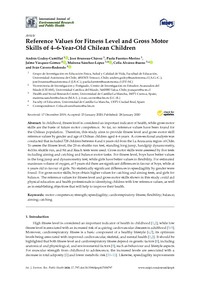Reference values for fitness level and gross motor skills of 4-6-year-old chilean children
Autor
Godoy Cumillaf, Andrés
Bruneau-Chávez, José
Fuentes-Merino, Paola
Vásquez-Gómez, Jaime A.
Sánchez-López, Mairena
Alvárez-Bueno, Celia
Cavero-Redondo, Iván
Fecha
2020Resumen
In childhood, fitness level is considered an important indicator of health, while gross motor skills are the basis of future motor competence. So far, no reference values have been found for the Chilean population. Therefore, this study aims to provide fitness level and gross motor skill reference values by gender and age of Chilean children aged 4‒6 years. A cross-sectional analysis was conducted that included 728 children between 4 and 6 years old from the La Araucanía region of Chile. To assess the fitness level, the 20-m shuttle run test, standing long jump, handgrip dynamometry, 4x10m shuttle run, and Sit and Reach tests were used. Gross motor skills were assessed by five tests including aiming and catching and balance motor tasks. For fitness level, boys have better values in the long jump and dynamometry test, while girls have better values in flexibility. For estimated maximum volume of oxygen, at 5 years old there are significant differences in favour of boys, while at 6 years old in favour of girls. No statistically significant differences in speed/agility by gender were found. For gross motor skills, boys obtain higher values for catching and aiming tests, and girls for balance. The reference values for fitness level and gross motor skills shown in this study could aid physical education and health professionals in identifying children with low reference values, as well as in establishing objectives that will help to improve their health.
Fuente
International journal of environmental research and public health, 17(3)Identificador DOI
doi.org/10.3390/ijerph17030797Colecciones
La publicación tiene asociados los siguientes ficheros de licencia:


